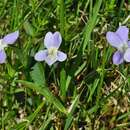Biology
provided by Arkive
The fen violet is a short-lived perennial species (2), which begins to flower in May (4) and has an unpredictable pattern of occurrence (3). The seeds are known to be resilient and need disturbance of the ground to allow them to germinate (4).
Conservation
provided by Arkive
The fen violet is included in English Nature's Species Recovery Programme. English Nature is funding a monitoring programme for the species, and seed has been collected for the Millenium Seed Bank at the Royal Botanic Gardens Kew, and for the University of Oxford's Botanic Garden (4). There are plans to introduce the species to a site where it can be appreciated by the public (4). Both of the Cambridgeshire sites where fen violet occurs are National Nature Reserves (3), and the species is fully protected under Schedule 8 of the Wildlife and Countryside Act 1981 (1).
Description
provided by Arkive
This speices is perhaps the rarest (3), and most beautiful of all our native violets (2). The fragile looking flowers are bluish-white in colour and usually have a sheen reminiscent of mother-of-pearl (2).
Habitat
provided by Arkive
Inhabits damp habitats such as fens, in short calcareous grass with a tendency to flood in winter and where there is occasional grazing or disturbance. (2).
Range
provided by Arkive
Once known from a number of locations in the south of Britian, the fen violet is now restricted to a single site in Oxfordshire (4) and just two sites in Cambridgeshire; Wicken Fen and Woodwalton Fen (3). The species occurs in Continental Europe, where it is also rare (4).
Status
provided by Arkive
Classified as Endangered in Great Britain (6), and fully protected under Schedule 8 of the Wildlife and Countryside Act, 1981 (1).
Threats
provided by Arkive
Habitat loss, drainage and inapropriate management of fenland sites have contributed to the decline of this violet (3).
Viola persicifolia
provided by wikipedia EN
Viola persicifolia, the fen violet,[1] is a violet (family Violaceae), native to central and northern Europe and northern Asia. In the British Isles it is very rare, occurring in a few fens in England and near the western coast of Ireland.
Description
The fen violet grows to a height of 10 to 30 cm (4 to 12 in) from a creeping rhizome, with narrow, triangular leaves 7 to 15 mm (0.28 to 0.59 in) across. The flowers are produced in late spring to early summer, 10 to 15 mm (0.4 to 0.6 in) diameter, pale bluish or yellowish-white with a short, greenish or yellowish spur. The petals are rounded and broad in relation to their width.[2][3]
Distribution and habitat
This violet occurs in native to central and northern Europe and northern Asia. Its habitat is confined to very local damp, lime-rich places, in long herbage (fens and limy marshes).[2]
The plant is fussy about where it grows; seeds germinates in the spring on moist bare patches of base-rich peaty soil, but the seedlings only become established if the soil surface becomes drier. Most seeds germinate in close proximity to the parent plant so dispersal is limited. Habitat disturbance may cause the violet to disappear from a former habitat, but the seeds are very long-lived and new plants sometimes appear many years later.[2]
In the British Isles, it is rare, confined to eastern and northern England and damp hollows with limestone soils in western Ireland. Efforts are being made to re-introduce it to newly suitable habitat in the Fens as part of the Great Fen Project.[4][5] It occurs at a few locations in Northern Ireland, on rocky limestone lake shores around Upper Lough Erne and in turloughs or ephemeral pools around Fardrum, in County Fermanagh, and because of its rarity there, it is listed as a Northern Ireland Priority Species.[2]
References

- license
- cc-by-sa-3.0
- copyright
- Wikipedia authors and editors
Viola persicifolia: Brief Summary
provided by wikipedia EN
Viola persicifolia, the fen violet, is a violet (family Violaceae), native to central and northern Europe and northern Asia. In the British Isles it is very rare, occurring in a few fens in England and near the western coast of Ireland.
- license
- cc-by-sa-3.0
- copyright
- Wikipedia authors and editors

